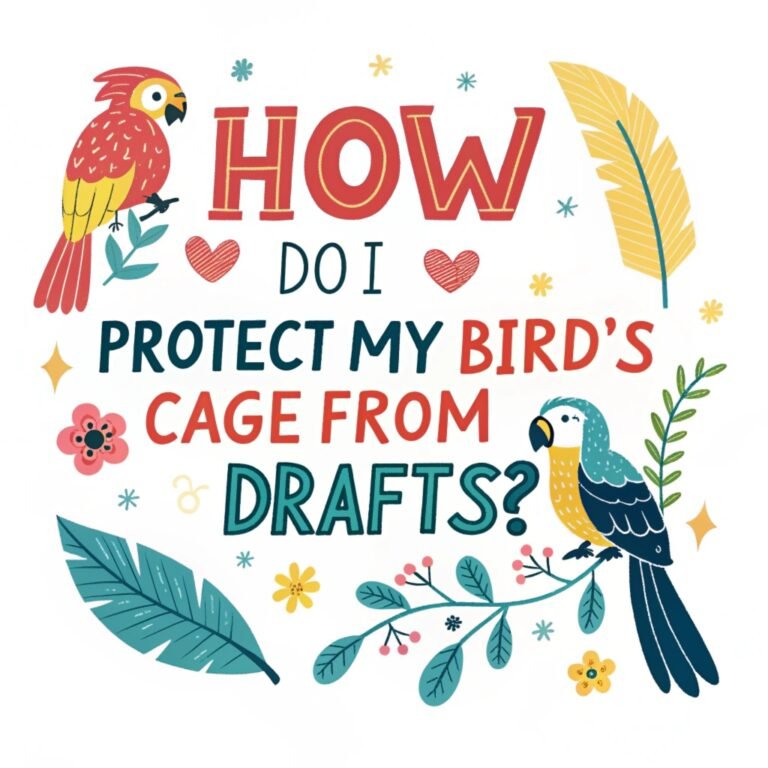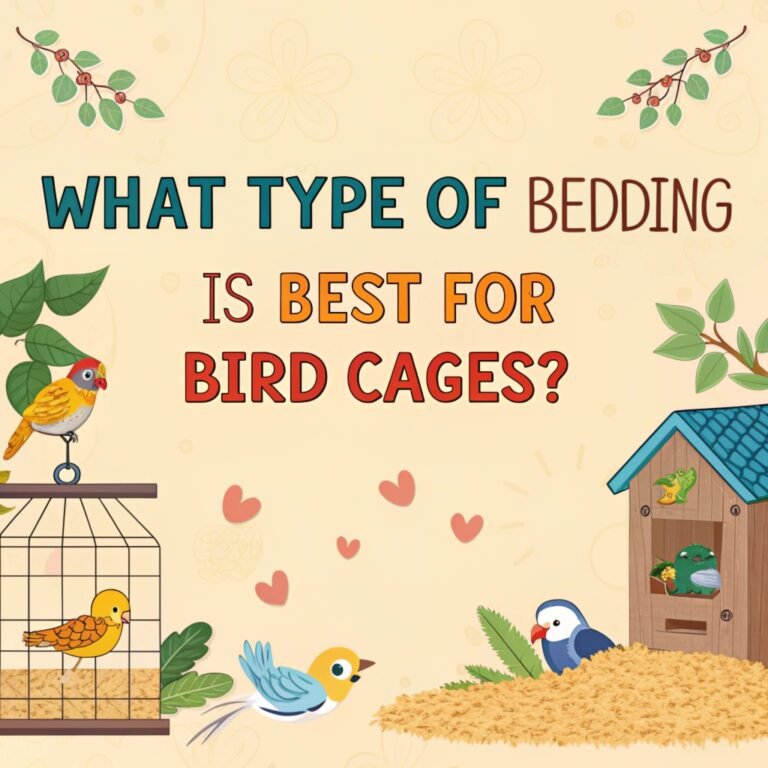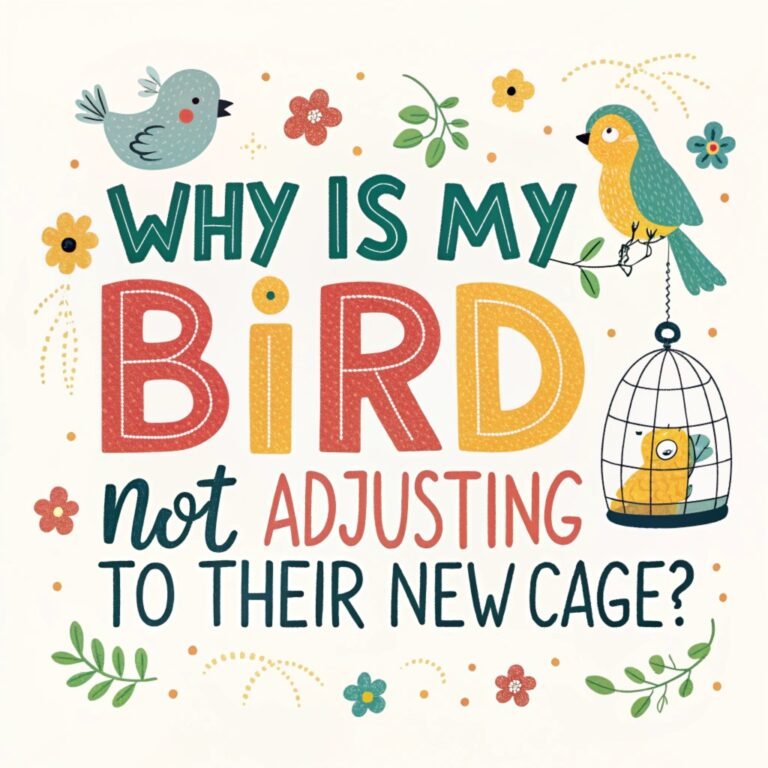Should I Cover My Bird’s Cage at Night? Exploring the Pros and Cons of This Practice
Ensuring your bird’s well-being is a top priority for any responsible pet owner. One common question that often arises is whether to cover a bird’s cage at night.
This decision can significantly impact your feathered friend’s sleep quality, stress levels, and overall health.
In this comprehensive guide, we’ll explore the pros and cons of covering your bird’s cage, factors to consider, and best practices to implement for your avian companion’s nighttime routine.

Key Takeaways
Before delving into the details, here are some essential points to consider regarding covering your bird’s cage at night:
- Mimicking natural habitat: Covering the cage can simulate the darkness and security of a bird’s natural sleeping environment.
- Improved sleep quality: A covered cage can reduce external stimuli, potentially leading to better rest for your bird.
- Species-specific needs: Different bird species may have varying preferences for darkness and coverage.
- Individual preferences: Some birds may feel more secure with a cover, while others might prefer an uncovered cage.
- Environmental factors: Consider room temperature, airflow, and ambient noise when deciding to use a cage cover.
- Safety considerations: Ensure the cover is secure and doesn’t pose a risk of entanglement or overheating.
- Gradual introduction: If introducing a cover, do so slowly to allow your bird to adjust.
- Observation: Monitor your bird’s behavior to determine if the cover is beneficial or causing stress.
- Consistency: Establish a regular routine for covering and uncovering the cage to help regulate your bird’s sleep cycle.
- Partial coverage: Consider covering only part of the cage if full coverage causes anxiety.
- Night lights: Some birds may benefit from a dim night light to prevent night frights.
- Ventilation: Choose breathable materials for cage covers to ensure proper air circulation.
- Seasonal adjustments: Adapt your covering strategy based on changing daylight hours and temperatures throughout the year.
- Health benefits: Proper sleep can contribute to your bird’s overall health and well-being.
- Behavioral impact: A good night’s rest can lead to improved behavior and reduced stress during the day.
Understanding Your Bird’s Natural Sleep Patterns
In the wild, birds typically follow a circadian rhythm that aligns with the natural cycle of day and night.
Most birds are diurnal, meaning they are active during daylight hours and sleep at night. However, the specific sleep requirements can vary among species.
Parrots, for instance, generally need about 10-12 hours of sleep per night to maintain optimal health. Understanding your bird’s natural sleep patterns is crucial in deciding whether to cover their cage.
Some species may be more sensitive to light and noise, making a cover beneficial, while others might prefer a more open sleeping arrangement.
Observing your bird’s behavior and consulting with an avian veterinarian can help you determine the best approach for your feathered friend’s sleep routine.
The Benefits of Covering Your Bird’s Cage

Covering your bird’s cage at night can offer several advantages for your feathered companion. Firstly, it helps create a dark environment that mimics the natural conditions birds experience in the wild, potentially leading to better quality sleep.
The cover acts as a barrier against external stimuli such as sudden lights or movements, which could otherwise disturb your bird’s rest.
Additionally, a covered cage can provide a sense of security for birds, as it resembles the enclosed spaces they would seek for protection in nature.
This feeling of safety can help reduce stress and anxiety, particularly for more nervous or easily startled birds.
Moreover, a consistent covering routine can help regulate your bird’s internal clock, signaling when it’s time to sleep and wake up, which is especially beneficial for birds kept in environments with artificial lighting.
Potential Drawbacks of Cage Covering
While covering a bird’s cage can be beneficial, it’s important to consider potential drawbacks. Some birds may feel anxious or trapped when their cage is fully covered, especially if they’re not accustomed to it.
This can lead to stress or night frights, where birds become startled and flap around their cage, potentially injuring themselves.
Additionally, if the cover is not breathable or properly secured, it can create issues with air circulation or pose a risk of entanglement.
Overheating is another concern, particularly in warmer climates or if the room temperature is not well-regulated.
Some birds may also develop an over-dependence on darkness for sleep, making it difficult for them to rest during daytime hours when necessary.
It’s crucial to observe your bird’s reaction to cage covering and adjust your approach accordingly to ensure their comfort and well-being.
Factors to Consider When Deciding to Cover

Several factors should influence your decision to cover your bird’s cage at night. First, consider your bird’s species and natural habitat.
Birds from tropical regions may prefer warmer, darker environments, while those from more temperate climates might be comfortable with some ambient light.
The individual personality of your bird also plays a role; some birds feel secure when covered, while others may become anxious. Assess your home environment, including room temperature, air circulation, and noise levels.
If you live in a noisy area or have a busy household, covering the cage might be beneficial. However, ensure that the cover doesn’t impede airflow or cause overheating.
Additionally, consider your bird’s age and health status. Younger birds or those with health issues might require more careful monitoring if you decide to cover their cage.
Choosing the Right Cover for Your Bird’s Cage
Selecting an appropriate cover for your bird’s cage is crucial for their comfort and safety. Opt for breathable materials like cotton or specially designed bird cage covers that allow for adequate air circulation.
Avoid materials that could fray easily, as loose threads pose a risk of entanglement. The cover should be easy to clean and durable enough to withstand daily use.
Consider covers with adjustable features, such as flaps or sections that can be partially opened, allowing you to customize the level of coverage based on your bird’s preferences.
Some covers come with built-in night lights or have light-filtering properties, which can be helpful for birds prone to night frights.
Ensure the cover fits your cage properly, leaving no gaps that could allow drafts or enable your bird to become entangled.
Remember, the ideal cover should provide darkness and security without compromising your bird’s safety or comfort.
Implementing a Cage Covering Routine
Establishing a consistent cage covering routine is essential for your bird’s well-being. Start by introducing the cover gradually, allowing your bird to become accustomed to it over time.
Begin with short periods of partial coverage, slowly increasing the duration and extent of coverage as your bird becomes more comfortable.
Aim to cover the cage at approximately the same time each evening, ideally coinciding with the natural sunset or your bird’s observed sleepy behavior. Similarly, uncover the cage at a consistent time each morning, mimicking the natural dawn.
This regularity helps reinforce your bird’s circadian rhythm. When covering the cage, move slowly and speak softly to avoid startling your bird.
If your bird shows signs of distress, such as increased vocalization or agitation, adjust your approach. Remember, the goal is to create a calm, secure environment that promotes restful sleep.
Monitoring Your Bird’s Response to Cage Covering
Closely observing your bird’s behavior is crucial when implementing a cage covering routine. Look for signs that indicate whether your bird is comfortable with the cover.
Positive signs include settling down quickly, reduced vocalization at night, and waking up energetic and alert in the morning.
Conversely, signs of distress may include increased agitation when the cover is applied, night frights, or seeming lethargic during the day. Pay attention to any changes in your bird’s eating habits, activity levels, or overall demeanor.
Some birds may take time to adjust to a new routine, so be patient and consistent. If your bird consistently shows signs of stress or discomfort with the cover, consider alternatives such as partial coverage or using a night light.
Always prioritize your bird’s well-being and be willing to adjust your approach based on their individual needs and preferences.
Alternatives to Full Cage Covering
If full cage covering doesn’t suit your bird, there are several alternatives to consider. Partial covering is one option, where you cover only a portion of the cage, allowing your bird to choose between darker and lighter areas.
This can be particularly helpful for birds that feel anxious when fully enclosed.
Another alternative is using a night light or dim lamp near the cage to provide a low level of illumination, which can help prevent night frights while still signaling that it’s time to sleep.
Some bird owners opt for light-filtering curtains or blinds in the room instead of covering the cage directly. This approach can create a darker environment without the potential stress of a cage cover.
Sound machines that produce white noise or nature sounds can also help create a calming atmosphere without the need for physical coverage.
Remember, the goal is to create a restful environment that makes your bird feel secure, so be open to experimenting with different methods to find what works best for your feathered friend.
The Impact of Cage Covering on Bird Behavior
The practice of covering a bird’s cage can have significant effects on their behavior. When done correctly, it can lead to improved sleep quality, which in turn can result in a calmer, more balanced bird during waking hours.
Birds that get adequate rest are often more active, playful, and less prone to stress-related behaviors such as feather plucking or excessive screaming.
Consistent cage covering can also help regulate hormonal cycles in some species, potentially reducing aggressive or territorial behaviors.
However, if a bird feels uncomfortable with cage covering, it may lead to increased anxiety, night frights, or a reluctance to sleep. This stress can manifest in daytime behavior problems, such as increased aggression or fearfulness.
It’s essential to pay attention to any changes in your bird’s behavior, both during covered periods and throughout the day, to ensure that the cage covering routine is having a positive impact on their overall well-being.
Seasonal Considerations for Cage Covering
The changing seasons can influence your bird’s need for cage covering. During summer months, when days are longer, you might need to cover the cage earlier to ensure your bird gets enough darkness for proper sleep.
Conversely, in winter, with shorter days, you may need to adjust the covering schedule to prevent your bird from sleeping excessively.
Be mindful of temperature fluctuations throughout the year. In warmer months, ensure the cover doesn’t trap heat, potentially leading to overheating.
During colder seasons, the cover can provide additional warmth, but make sure it doesn’t impede necessary air circulation.
Some bird owners use different types of covers seasonally, opting for lighter, more breathable materials in summer and cozier options in winter.
Additionally, consider how seasonal changes in daylight might affect your bird’s mood and behavior, adjusting your covering routine as needed to maintain a consistent sleep schedule and promote overall well-being.
Health Benefits of Proper Sleep for Birds
Ensuring your bird gets adequate, quality sleep through appropriate cage covering can have numerous health benefits. Proper sleep is crucial for a bird’s immune system, helping them fight off diseases and recover from illness more effectively.
It also plays a vital role in cognitive function, supporting memory formation and learning abilities.
Good sleep habits can contribute to better emotional regulation, reducing stress and anxiety-related behaviors.
For many bird species, consistent sleep patterns help maintain healthy hormonal balances, which can influence everything from molting cycles to breeding behaviors.
Adequate rest is also essential for physical recovery, allowing muscles and tissues to repair and regenerate.
Birds that sleep well often display more vibrant plumage and maintain a healthier weight.
By providing an environment conducive to restful sleep, you’re supporting your bird’s overall health, potentially leading to a longer, happier life for your feathered companion.
Common Mistakes to Avoid When Covering Your Bird’s Cage
When implementing a cage covering routine, it’s important to be aware of common pitfalls that could negatively impact your bird’s well-being.
One frequent mistake is using inappropriate materials for covers, such as non-breathable fabrics that can lead to poor air circulation or overheating.
Another error is covering the cage too tightly, which can make the bird feel trapped and anxious.
Some bird owners make the mistake of covering the cage for too long, exceeding the bird’s natural sleep requirements and potentially disrupting their circadian rhythm.
Inconsistent covering schedules can also be problematic, as birds thrive on routine. Failing to monitor your bird’s reaction to the cover and adjust accordingly is another common oversight.
Additionally, neglecting to clean the cover regularly can lead to hygiene issues. Lastly, abruptly introducing a full cover without a gradual acclimation period can be stressful for your bird.
By avoiding these mistakes and approaching cage covering thoughtfully, you can create a more positive sleep environment for your avian companion.
Expert Opinions on Cage Covering
Avian veterinarians and bird behavior specialists generally agree that cage covering can be beneficial for many birds, but stress the importance of tailoring the approach to each individual bird’s needs.
Dr. Brian Speer, a renowned avian veterinarian, suggests that cage covering can help reduce stress and promote better sleep patterns in many species.
However, he emphasizes the need for proper ventilation and monitoring of the bird’s response. Certified Parrot Behavior Consultant Pamela Clark notes that while cage covering can be helpful, it’s not a one-size-fits-all solution.
She recommends observing the bird’s behavior closely and being willing to adjust the covering routine as needed.
Some experts also point out that cage covering can be particularly beneficial for birds in busy households or urban environments with high levels of ambient light and noise.
However, they caution against using covering as a substitute for addressing underlying behavioral or environmental issues that may be affecting a bird’s sleep quality.
Frequently Asked Questions
Q: How long should I cover my bird’s cage?
A: Most birds need about 10-12 hours of sleep. Cover the cage when it gets dark and uncover it in the morning, adjusting for seasonal changes in daylight.
Q: Can I partially cover the cage?
A: Yes, partial covering can be a good option, especially for birds that feel anxious with full coverage. It allows them to choose between darker and lighter areas.
Q: What material should I use for a cage cover?
A: Use breathable, washable fabrics like cotton. Avoid materials that fray easily or trap heat.
Q: Should I cover my bird’s cage during daytime naps?
A: It’s generally not necessary to cover the cage for daytime naps. Natural light during the day helps maintain your bird’s circadian rhythm.
Q: How can I tell if my bird likes being covered?
A: Signs of comfort include settling down quickly, quiet behavior, and waking up energetic. Signs of distress include agitation, night frights, or seeming lethargic during the day.
Q: Is it okay to use a night light with a covered cage?
A: Yes, a dim night light can be helpful, especially for birds prone to night frights. Ensure it doesn’t disrupt their sleep.
Q: How do I introduce a cage cover to my bird?
A: Start gradually, covering only a portion of the cage for short periods. Slowly increase coverage as your bird becomes comfortable.
Q: Can covering the cage help with behavioral issues?
A: Proper sleep can improve overall behavior, but covering shouldn’t be used as a solution for underlying behavioral problems. Consult an avian behaviorist for persistent issues.
Q: Should I cover my bird’s cage if I have multiple birds?
A: If your birds are housed together, you can cover their cage. If in separate cages, consider their individual preferences and adjust accordingly.
Q: How often should I wash the cage cover?
A: Wash the cover weekly or more frequently if soiled. Regular cleaning helps maintain a hygienic environment for your bird.

Hello, I’m Amelia White, the founder of birdsfanatic.com. As a lifelong bird enthusiast and spiritual seeker, I’ve always been fascinated by the mystical connections between birds and the human experience. On this site, I share my knowledge and insights into the symbolic meanings and spiritual significance of various bird species, exploring their roles in mythology, folklore, and cultural traditions. Join me on this journey into the world of birds, where we’ll discover the hidden wisdom and guidance that these magnificent creatures have to offer.







